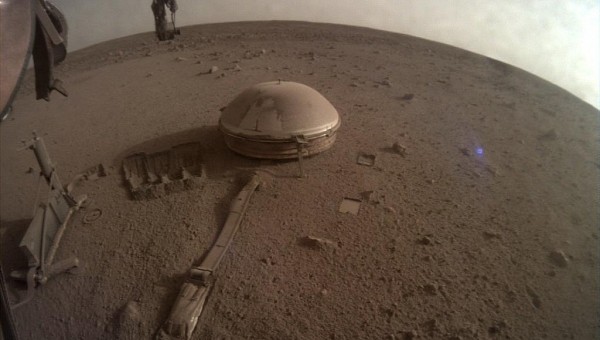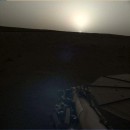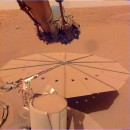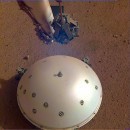After listening for quakes on Mars for four years, the InSight lander has signed off. Dust storms have been suffocating the machine for the past few months, threatening the mission. Now, NASA officially retired the spacecraft after tweeting a heartbreaking farewell message from InSight.
"My power's really low" – that's how the message tweeted by NASA starts. The thick layer of dust accumulated on the lander's solar panels only got worse after a massive dust storm swirled over Mars' southern hemisphere earlier this year. As a result, InSight continued to lose power.
Since it arrived on Mars in 2018, things didn't go as smoothly as the agency hoped. The lander carried an array of scientific instruments, including a spike-like heat probe nicknamed "the mole" that was supposed to bury itself 16 ft (5 meters) into the Martian ground in order to measure the planet's internal temperature.
The mole couldn't get too far since the soil around InSight was clumpy. Even though the instrument could bury itself just below the surface, it was nevertheless able to gather some significant information on the temperature and physical characteristics of the Martian soil. And that was possible thanks to the lander's robotic arm.
The arm, together with its scoop, also played a crucial role in helping the spacecraft get an energy boost. Scientists came up with a clever idea: they commanded the rover to use its robotic arm to scoop up some dirt and place it on the already dust-covered solar panels. This way, sudden bursts of wind pushed the dirt off the panels, which carried with it fine particles of dust.
But the robotic arm wasn't the only valuable thing the lander possessed. Using the scientific instruments onboard, InSight analyzed the core of the planet and looked for marsquakes. In total, it was able to feel the ground shake 1,319 times. Not only that, but it also was able to detect quakes caused by meteoroid impacts, including one that had a magnitude of 4.
But InSight was slowly losing power since its panels kept accumulating dust. The team knew that its final days were numbered, so it tried to squeeze the most that it could out of the spacecraft. The team shut down some of the instruments to preserve power. In the end, the seismometer was the last one to remain powered on.
The spacecraft's energy levels continued to drop, so NASA decided to declare the mission over if InSight missed two consecutive communication sessions. InSight last made contact with Earth on December 15th. After two unsuccessful attempts to get in touch with the lander, mission controllers at NASA's Jet Propulsion Laboratory (JPL) came to the conclusion that the spacecraft's batteries had run out of power. Even if the probability of hearing from the lander at this point is relatively low, the agency will keep listening for a signal.
"We've thought of InSight as our friend and colleague on Mars for the past four years, so it's hard to say goodbye," said Bruce Banerdt, the mission's principal investigator. "But it has earned its richly deserved retirement."
Since it arrived on Mars in 2018, things didn't go as smoothly as the agency hoped. The lander carried an array of scientific instruments, including a spike-like heat probe nicknamed "the mole" that was supposed to bury itself 16 ft (5 meters) into the Martian ground in order to measure the planet's internal temperature.
The mole couldn't get too far since the soil around InSight was clumpy. Even though the instrument could bury itself just below the surface, it was nevertheless able to gather some significant information on the temperature and physical characteristics of the Martian soil. And that was possible thanks to the lander's robotic arm.
The arm, together with its scoop, also played a crucial role in helping the spacecraft get an energy boost. Scientists came up with a clever idea: they commanded the rover to use its robotic arm to scoop up some dirt and place it on the already dust-covered solar panels. This way, sudden bursts of wind pushed the dirt off the panels, which carried with it fine particles of dust.
But the robotic arm wasn't the only valuable thing the lander possessed. Using the scientific instruments onboard, InSight analyzed the core of the planet and looked for marsquakes. In total, it was able to feel the ground shake 1,319 times. Not only that, but it also was able to detect quakes caused by meteoroid impacts, including one that had a magnitude of 4.
But InSight was slowly losing power since its panels kept accumulating dust. The team knew that its final days were numbered, so it tried to squeeze the most that it could out of the spacecraft. The team shut down some of the instruments to preserve power. In the end, the seismometer was the last one to remain powered on.
The spacecraft's energy levels continued to drop, so NASA decided to declare the mission over if InSight missed two consecutive communication sessions. InSight last made contact with Earth on December 15th. After two unsuccessful attempts to get in touch with the lander, mission controllers at NASA's Jet Propulsion Laboratory (JPL) came to the conclusion that the spacecraft's batteries had run out of power. Even if the probability of hearing from the lander at this point is relatively low, the agency will keep listening for a signal.
"We've thought of InSight as our friend and colleague on Mars for the past four years, so it's hard to say goodbye," said Bruce Banerdt, the mission's principal investigator. "But it has earned its richly deserved retirement."
My power’s really low, so this may be the last image I can send. Don’t worry about me though: my time here has been both productive and serene. If I can keep talking to my mission team, I will – but I’ll be signing off here soon. Thanks for staying with me. pic.twitter.com/wkYKww15kQ
— NASA InSight (@NASAInSight) December 19, 2022









